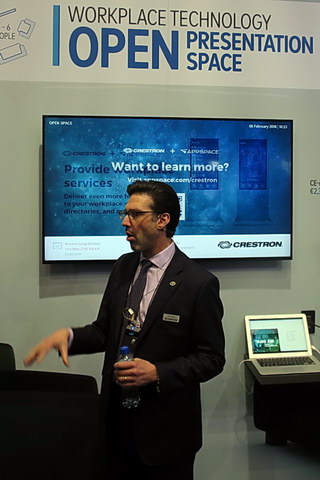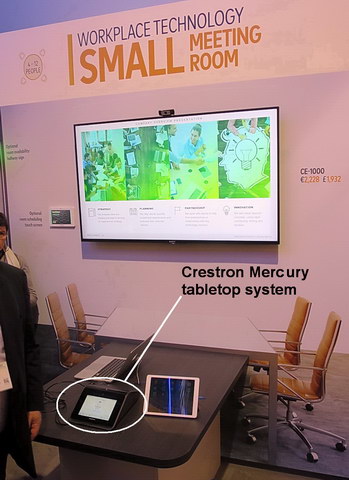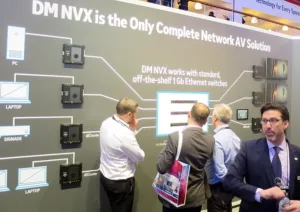First thing after the ribbon cutting ceremony on the opening day of ISE, I got a media booth tour of the Crestron booth led by Jeff Singer, the Executive Director of Product Marketing. Crestron makes control, management and content transport systems for AV . Crestron technology is often used for very large systems, including multi-national corporations, and allows things like room control and scheduling, in addition to AV and video conferencing technology. Crestron is a supplier of both the hardware and the software needed for this global AV integration.
 Jeff Singer explains Crestron’s technology to the media. (Credit: M. Brennesholtz)
Jeff Singer explains Crestron’s technology to the media. (Credit: M. Brennesholtz)
Singer emphasized Crestron provides five things as part of its systems. First, users are assured of a consistent user experience, regardless of conditions like the size of the room, the location of the room in the building or the location of the building around the world. Second, he said, when a company chooses a Crestron control system, the company can continue to use existing hardware. Third, he emphasized that the Crestron network was secure.
Security actually has two main facets: security of the communications over the network and in the cloud plus security to ensure only authorized people use a room. Next, he said the system can be deployed and maintained remotely. Finally, he said, a Crestron system allows the scheduling and booking of rooms. This last feature is important, he said, because it prevents time-wasting conflicts that occur when someone moves into a conference or huddle room for a teleconference without realizing the room was already reserved by someone else.
 Crestron CE-1000 small meeting room solution. (Credit: M. Brennesholtz)
Crestron CE-1000 small meeting room solution. (Credit: M. Brennesholtz)
In keeping with the rising concept of “experience” over hardware and software, Crestron has begun to sell complete, pre-integrated rooms for a variety of applications, especially for video conferencing. For example, the Crestron CE-1000 small room meeting solution for 4 – 12 people includes the Crestron Mercury Tabletop Meeting Solution, HD conferencing camera, Infrared control, and four cables. The furniture and the main display in the room are not from Crestron but are customer or integrator-supplied.
Due to the complexity of global AV systems, or even just building-wide AV systems, virtually all Crestron customers use an integrator to design and install their systems. Singer said one of the advantages of a pre-designed room such as the CE-1000 is that it allows a global company to have the same system in many, sometimes thousands, rooms worldwide. Crestron also offers pre-packaged solutions for medium and large conference rooms, allowing a company to standardize on only a few room types, worldwide.
The Cloud Speeds Deployment
One new product Singer discussed was XiO Cloud. This is a software framework designed to control and manage cloud-based AV and building control systems. It is said to require less time and labor for system deployment. One of the features of XiO Cloud is that new devices can be configured in advance. The device is then plugged into the local network and it is automatically configured to match that network.
The system also allows changes to device settings to be made once and then applied globally; monitor device performance and report problems; respond to “events”; transfer settings to future, similar devices and add features and manage licenses. In terms of managing licenses, for example, if a company location has 30 meeting rooms but history has shown that never more than 10 of them use a particular software license at any given time, the customer can buy only 10 licenses and XiO Cloud will allocate the licenses to the rooms needing the license for a meeting.
Fusion is the existing software framework used by Crestron. When asked, Singer said that Fusion was not being dropped and will continue to be supported and developed by Crestron for at least 10 years. He added, as an example of how Crestron continues to support older systems, that some of the Crestron hardware at customers’ locations that is 10 and even 20 years old is still supported by Crestron and is often used side-by-side with newer Crestron hardware.
Jeff Singer discusses Crestron’s DM NVX AV over IP system. (Credit: M. Brennesholtz)
Singer also explained and demonstrated DM NVX, which is Crestron’s system for providing real-time video content over 1Gb Ethernet. He said it works with standard 1Gb Ethernet cables and switchers, which are currently the default installation for most companies. The new features from Crestron for DM NVX in 2018 are support for Dante and AES67 audio codecs.
He said many competitive video over IP solutions require 10Gb cables and switchers but don’t provide improved video quality. Crestron had a side-by-side demo of 4K60 video transmitted by DM NVX over 1Gb Ethernet compared to a competitor’s (AMX SVSI) solution that required 10Gb Ethernet. Video quality of the test material I saw was actually superior on the DM NVX system although you have to keep in mind that the test material in the demo was selected by Crestron. –Matthew Brennesholtz

